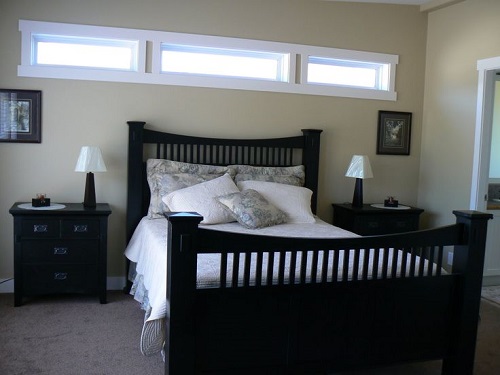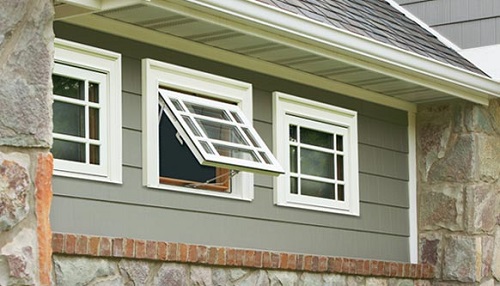Domestic windows
Contents |
[edit] Introduction
Domestic windows are commonly made from timber, uPVC, aluminium. They are available in a wide range of colours and finishes and can be purchased off the shelf in standard sizes or can be made to measure.
They can include single, double or triple glazing, and their performance can be improved by low-e coatings, or by filling the gap between panes of glass with gases such as argon.
The BFRC Window Energy Rating (WER) scheme is based on a traffic-light style A-G ratings system for energy efficiency similar to that used for fridges, washing machines, cookers and so on. An A rating indicates a good level of energy efficiency, whilst G is the lowest possible rating.
There are several different types of window commonly found in domestic buildings.
[edit] Bay or bow windows
Bay windows are multi-panel windows that project in front of the external wall line, supported by a sill height wall. Bow windows are a curved variation. They are typically used in communal rooms such as the living room, dining room, kitchen, and so on.
As they generally protrude from the exterior of the house, they have the advantage of providing more interior space. Generally, they comprise a stationary window in the middle which is flanked by either double-hung windows or casements.
Bay or bow windows allow light to enter at different angles and lateral panels can be opened to allow airflow.
For more information, see Bay window.
[edit] Stationary window
Also known as a fixed light window, this type of window is fixed in place and cannot be opened. They are often used where light or vision alone is required rather than ventilation, but they are commonly used in conjunction with other openable types of window.
[edit] Slider window
Glass is fitted in ‘sashes’ (moveable panels) that slide horizontally past each other on guide rails within the frame. These are commonly found on modern or contemporary houses.
[edit] Transom window
This is a horizontal window that is commonly mounted above a door or another window to let in more light. It can either be stationary or operational, meaning that it can be opened to allow ventilation.
[edit] Picture window
This is a large stationary window that lets in the maximum amount of light and provides external views. Picture windows are most commonly found in modern houses where ventilation is not important.
[edit] Awning window
This type of window is hinged at the top and can be opened outwards, allowing ventilation. They are often installed above, below or alongside a stationary or operating window. They are typically found in bedrooms and bathrooms, where privacy is required as well as adequate light and air.
[edit] Casement window
This type of window is hinged and can be opened outwards. They can be found in a variety of formats but are typically made in modular, standard sizes in order to keep costs to a minimum.
[edit] Sash window
Sash windows are typically found in Georgian and Victorian buildings but are still widely used in new buildings. Sash windows consist of two sashes that slide vertically up and down in the frame.
See this link for more on sash windows,
[edit] Rooflight / skylight
A dome light, lantern light, skylight, ridge light, glazed barrel vault or other element intended to admit daylight through a roof, and installed on an upstand so that it is not in the same plane as the surrounding roof.
For more information see: Rooflight.
[edit] Roof window.
A roof window is a window installed in the same plane as the surrounding roof, with a minimum pitch of 15 degrees. This is as opposed to a rooflight which is installed on an upstand, and so is not in the same plane as the surrounding roof.
[edit] Others
Other types of domestic window include:
- Secondary glazing.
- Tilt and turn.
- Pivot.
- Bi-fold.
- Louvre.
- Tilt and slide.
- Toplight.
- Sidelight.
- Clerestory.
- Multi-lite.
- Stained glass.
- Topguided.
- Sidehung.
- Dormer.
For more information, see Window.
[edit] Related articles on Designing Buildings Wiki
- Bay window.
- Bullseye window.
- Casement.
- Crittall metal windows.
- Domestic roofs.
- Dormer window.
- Double glazing.
- Double glazing v triple glazing.
- Fenestration.
- Glass.
- Glazing.
- Low-e glass.
- Rooflight.
- Sash windows.
- Secondary glazing.
- Triple glazing.
- Types of window.
- Window.
- Window energy rating.
- Window frame.
- Witch window.
- Yorkshire Lights.
Featured articles and news
The history of building regulations
A story of belated action in response to crisis.
Moisture, fire safety and emerging trends in living walls
How wet is your wall?
Current policy explained and newly published consultation by the UK and Welsh Governments.
British architecture 1919–39. Book review.
Conservation of listed prefabs in Moseley.
Energy industry calls for urgent reform.
Heritage staff wellbeing at work survey.
A five minute introduction.
50th Golden anniversary ECA Edmundson apprentice award
Showcasing the very best electrotechnical and engineering services for half a century.
Welsh government consults on HRBs and reg changes
Seeking feedback on a new regulatory regime and a broad range of issues.
CIOB Client Guide (2nd edition) March 2025
Free download covering statutory dutyholder roles under the Building Safety Act and much more.
AI and automation in 3D modelling and spatial design
Can almost half of design development tasks be automated?
Minister quizzed, as responsibility transfers to MHCLG and BSR publishes new building control guidance.
UK environmental regulations reform 2025
Amid wider new approaches to ensure regulators and regulation support growth.
The maintenance challenge of tenements.
BSRIA Statutory Compliance Inspection Checklist
BG80/2025 now significantly updated to include requirements related to important changes in legislation.































